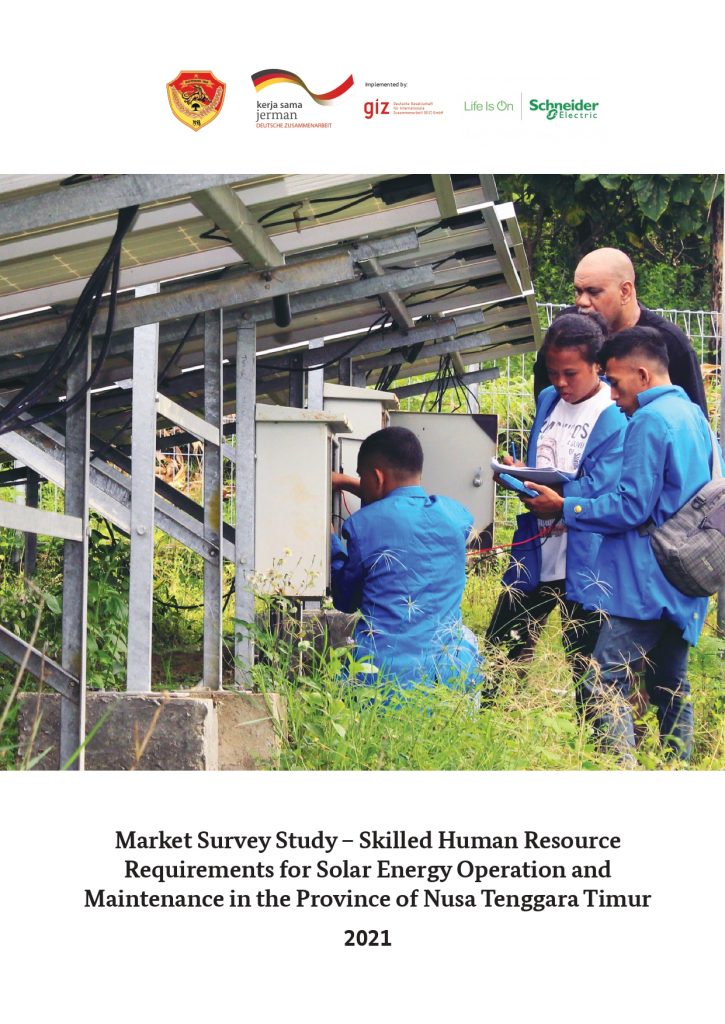Market Survey Study – Skilled Human Resource Requirements for Solar Energy Operation and Maintenance in the Province of Nusa Tenggara Timur
Market Survey Study – Skilled Human Resource Requirements for Solar Energy Operation and Maintenance in the Province of Nusa Tenggara Timur

This solar Photovoltaic (PV) market survey study in Nusa Tenggara Timur (NTT) Province provides a full perspective of regulatory and planning aspects to support PV development, skill development, and supply chain. This report offers an understanding of how the regional government reacts to Indonesia’s renewable energy commitment and draws a link to their commitment to skill development programs to support green growth. Additionally, this report provides an outlook on the market conditions in the province from the private sector and association perspectives.
The report is built upon secondary data, information extracted from procurement databases, Key Informant Interview (KII), Focus Group Discussion (FGD) and in-house analysis. Findings are presented in three main parts which are current conditions of the solar PV sector in NTT, supply chain mapping and lastly, looking at future solar PV plans, estimating future labour demand and analysing skill-demand gap in the current vocational education. There are a few notably findings highlighted in this report, among them are:
- The PV projects in NTT, by quantity, is highly driven by the government initiatives with characteristics of being off-grid, small-scale in capacity ≤100 kWp and community-based management. The central government also has introduced solar rooftops in a few public infrastructures and provided other distributed solutions such as Solar Home System (SHS) and solar street. While rooftop users data are traceable, the last mentioned is hard to get. Moreover, in all projects, operators are trained on the spot and no certifications are provided. Apart from that, PLN and donors were also contributing, with PLN is starting to adopt PV mini-grid to reach
- The supply chain mapping indicates that NTT lacks installers and Operation and Maintenance (O&M) providers. Projects were mostly developed by companies from outside NTT and skilled labour was hired from outside. Project developers acknowledged the difficulties of accessing the information on PV professionals in NTT due to a lack of data. While PLN acknowledged that it is difficult to find professionals who are willing to be placed in remote areas.
- Discussion and interviews with local governments, solar PV developers, TVET institutions, solar PV users/customers and prospect customers strengthened the finding that with no O&M providers and installers in NTT, the adoption of PV will likely be delayed. This issue on the demand side is among other aspects mentioned by our survey respondents and interview informants such as lack of local regulation, incentives and low purchasing power. While on the supply of labour, some issues are related to human resource competencies (lecturers/teachers/instructors) that have not met the needs both internally in vocational education and for industrial needs, lack/inadequate link and match program developed between SMK/BLK and industries, lack/inadequate alumni tracing system.
- While there is a clear roadmap on achieving a 100% electrification ratio in the government and PLN documents, there is no clear strategy yet in place to prepare skills to ensure that local labour can actively take the benefit of those projects in the futur
In a nutshell, the study concludes that there is an open opportunity for solar PV job creation in NTT, and to showcase that NTT can become the lead on solar PV skills as its location is perfect for solar PV and there is an intention to make the province as the solar barn for Indonesia. However, to benefit from this, NTT needs a clear roadmap on skill development and support with local regulations to attract private sector investment.
full report at : https://onedrive.live.com/?authkey=%21AM0T9IF4Oklk13E&cid=552965BF75CCFF13&id=552965BF75CCFF13%21146&parId=552965BF75CCFF13%21142&o=OneUp